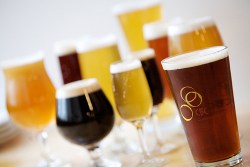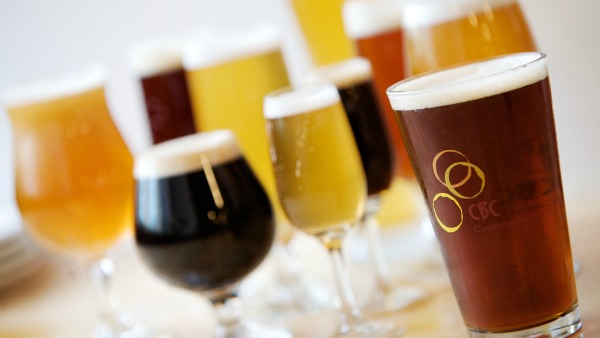
Cambridge Brewing Co.“If this beer isn’t organic, I’m going to be pissed … but I’m drinking it anyway.”
A few weeks ago I made the following — surprisingly controversial — statement:
Despite some well-intentioned efforts to brew and sell organic beer, the overall reaction from both consumers and brewers has been pretty meh.
It was the “meh” that launched a load of comments, a few angry emails, and even a phone call to my editor. I had to wonder: Did I “meh” too quickly? I decided to investigate further to find out.
“Organic” beer: Now actually organic
Until January 2013, the major difference between organic and non-organic beer was the organic barley. Brewers weren’t required to use organic hops (an ingredient that makes up less than 5 percent of a typical brew) largely because they simply weren’t readily available. But in 2010, the National Organic Standards Board announced a change that would take effect three years later: The hops in organic beer would now need to be organic, too.
So it’s organic — should we care?
As plenty of the commenters to the beer guide pointed out, the point of organic beer is not better taste. So then, what is the point? “Organic” is just about the way the barley, hops, and other agricultural products (added in small quantities for flavor) are grown. As Christian Ettinger of Hopworks Urban Brewery told me, the organic label “purely has to do with the ingredient strain,” meaning “there is no contamination by petrochemical fertilizers and pesticides.” Daniel Del Grande of Bison Organic Beer elaborated on this, noting that agricultural runoff, chemical exposure, and dangers to wildlife are all avoided in organic farming. “The microclimate in the soil, and all the bugs in the soil, which make for a healthy environment to grow, are present in organic agriculture and are largely lacking in conventional agriculture,” he says. It’s hard to argue with the fact that organic farming is better for the environment than standard farming practices, and you’d be hard-pressed to find anyone who thinks protecting workers from dangerous pesticides [PDF] is a bad thing.
Yet unlike conventional craft beer, which can easily win over non-environmentalists with nothing more than awesome tastiness, Del Grande admits that touting the eco-friendliness of organic beer is not a selling point for everyone. “Not everybody cares, you’re right — that’s why we have awesome flavors like honey basil, chocolate stout, and gingerbread ales,” he adds. “These are unique beers with a twist, and the fact that they’re organic is an added bonus.”
But how the crops are grown is just one small piece of a brewery’s carbon footprint. And when you also consider packaging, distribution, the brewing process itself, etc., it’s not totally clear that an organic beer will always have a smaller environmental impact than a non-organic beer. While a number of breweries hire outside groups to evaluate that impact, these studies are often crazy-complicated, and the results can’t be compared on a 1-to-1 basis — especially when they aren’t performed by the same environmental auditor. Bison, for example, commissioned ClimatePath in 2009 and found that every six-pack of beer they made generated 6.19 pounds of carbon dioxide. Meanwhile, in 2008, Climate Conservancy helped New Belgium assess its footprint per six-pack of Fat Tire at 7.03 pounds. In 2010, a reporter for the Guardian performed his own carbon footprint analysis and estimated that a six-pack of a local bottled beer (presumably non-organic) from a shop would leave a 6.61-pound carbon footprint. Without performing a scientific comparison of each of these reports (something I am certainly not qualified to do), it’s hard to know if a sub-pound of CO2 difference between a six-pack of organic and non-organic beer should be attributed to environmental practices, testing methodologies, or just plain margin of error.
If organic beer is so great, why is there so little of it?
There are two main explanations for why more brewers — typically an environmentally minded set — are not exclusively using organic ingredients: cost and ingredient availability.
The first will come as no surprise to anyone who has ever been in a supermarket: The organic version of everything simply costs more — whether you’re buying tomatoes, candy, or malted barley. That means brewers have two options: They can suck it up, eat the extra cost, and keep selling their beer at a competitive price; or they can raise the price of their beer and pass the financial burden onto customers. Brewers have gone both ways. Doug Bell, the national wine and beer buyer for Whole Foods, estimates that a six-pack of organic beer costs between $1 and $3 more than a comparable craft beer, so at least some organic brewers are passing the cost along. But going the other way — lowering the price and, therefore, the profit margin — doesn’t guarantee higher sales. New Belgium Brewery, for example, willingly took a financial hit with its short-lived organic Mothership Wit. New Belgium Sustainability Specialist Katie Wallace explains: “For years we sold Mothership Wit with a smaller profit margin because we believed in it.” Despite their efforts, a lack of consumer enthusiasm took it out of production.
But there is good news on this front: Prices have gone down as demand for organic ingredients has gone up, and making organic beer is not as expensive as it once was. Ettinger remembers a time when organic hops were priced at about $20 a pound (conventional varieties run $6-8 per pound). Current prices of $12-18 per pound are still more expensive than non-organics, but the cost difference of brewing organically actually works out to be relatively small: only 8 cents more per pint — just under $10 more per keg, and less than $20 more per barrel.
But even if organic ingredients cost the same as conventional ones, unless they were also as reliably and readily available, brewers might be reluctant about changing their sourcing. Even a huge supporter of organics, like Ron Silberstein of San Francisco’s ThirstyBear Brewing Company, has complaints. “I would totally agree with the statement out there that you can limit what you’re brewing when you choose to go organic because of availability of ingredients,” he says. “We’ve made some beers that aren’t exactly what we wanted to make because we just couldn’t get the hops that we wanted — or [for] the hops that we did get, the quality wasn’t there.” But not every brewer claims this problem. Ettinger says that finding the right ingredients five years ago was a challenge, but “more and more, it’s actually quite easy now.” The data backs him up to a degree: Even though the overwhelming majority of hops grown in this country are not organic, the numbers do show some promising growth. In 2009, organic hops made up 0.246 percent of the total hops in the country. By 2012, that number had increased to 1.12 percent.
The showdown: Organic versus local
OK, so we know organic agriculture is better for the planet. But what if the choices are between an organic product shipped in from across the country versus a craft beer brewed a few miles away? Which is the more environmentally friendly choice? Here’s where I revert to a phrase I used often in my prior life as a lawyer: It depends.
In a shock to no one, Del Grande urges consumers to choose organic over local, noting that most of the country’s barley is still grown in just a few states in the U.S. — which means “beer is not a local product,” even when it’s brewed nearby. Silberstein disagrees, though not without expressing genuine remorse. “I would have to say if the quality’s the same, go local. But it’s hard for me to say that, because organic is also about what you’re doing for the health of the soil, and the water table, and the workers.” Sarah Weiner, director of the Good Food Awards, doesn’t want to pick a team. “In absolute terms, neither is better than the other,” she says. “I hope in the future the confluence of both characteristics will become increasingly an option.”
The “meh” factor
So back to the three-letter word that caused such a ruckus. Has the response been meh? Again, it depends. On the one hand, organic beer sales have gone from $9 million in 2003 to $41 million in 2011, and the North American Organic Brewers Festival (NAOBF) will have 36 participating breweries (and two cideries) this year — more than double 2004’s 15. The prices on ingredients are dropping as more American farmers grow organic hops and barley, meaning that organic brewing is going to get cheaper and easier. And brewers like Del Grande, Ettinger, and Silberstein all report enthusiasm from their customers.
On the other hand, $41 million in sales loses some luster when compared to the $8.7 billion the craft brewing industry pulled in as a whole the same year. And 600 craft breweries plan to show up for the Great American Beer Festival. Even if the entire craft beer industry wanted to go organic today, there isn’t even close to enough organic ingredients to support it (or even a fraction of it). Widespread availability at watering holes remains a problem: Very few of the bars and restaurants I called and visited in New York City — a place famed for offering you pretty much anything at any time — carry domestic organic beer. (The East Village’s d.b.a. was the winner on this front; it serves Peak Organic Summer Session.) You’re better off getting your organic brew to go: The Whole Foods on Bowery beat out everyone by carrying seven domestic organic beers, including the very tasty Wolaver’s Wildflower Wheat (because it’s made with organic Vermont honey, Wolaver can check off boxes next to both “local” and “organic.”) “The category is still in its infancy,” Bell says. “Until there is a major player on the national stage with an organic beer, do not expect it on tap at your local beer hall.”
In the meantime, though, things seem to be moving (albeit very slowly) in a more organic and sustainable direction. “People are taking baby steps,” Weiner tells me, noting that a number of non-organic brewers have started incorporating organic ingredients, even if they aren’t advertising it. Chris Crabb of the NAOBF estimates that as many as 40 craft breweries in the country are now offering one-off organic brews. Doing another organic beer is still “on the table” for New Belgium, but they’re also proactively engaging farmers to explore other opportunities for increased sustainability. “It’s not just organic versus conventional, there are so many more options, and some of them might be smaller, incremental steps that are more achievable, more realistic,” Wallace says. One example: Salmon-Safe certification, which focuses on protecting salmon habitats. “Even if you’re farming organically, if you’re putting down a bunch of manure, that might all be running into the stream and causing some imbalances that are very problematic to wildlife.”
And so, readers, I stand by my “meh” — but only as a non-scientifically calculated assessment of mean reactions, not as a summary of all reactions everywhere, and certainly not as an evaluation of the organic beer industry as a whole.



